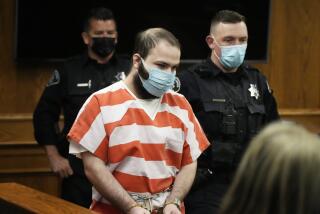James Holmes deserves to die, prosecutors tell jury as penalty phase begins
Prosecutors pushing for convicted murderer James E. Holmes to be put to death told jurors Wednesday that the failed neuroscience student they had found guilty not only killed 12 people during a midnight showing of âThe Dark Knight Rises,â but that he did so in a pitiless and unconscionable manner.
âAt the moment of their deaths, the victims would not only be in fear for their own lives, but in fear for the lives of their friends and family and loved ones,â prosecutor Richard Orman told the jury as the sentencing phase of Holmesâ trial began. âI submit to you that that would be worse than the fear that you would die yourself....
âThey died surrounded by screaming and by pain and by anguish,â Orman said. âThat is how they died. That is how he killed them. Dying like that is unnecessarily torturous. It is conscienceless. It is pitiless.â
Holmes was convicted last week of 165 counts, including first-degree murder and attempted murder in the July 20, 2012, Aurora, Colo., theater rampage that took a dozen lives and wounded 70 others.
Now, the jury that convicted him after just 12 hours of deliberation must decide whether he should die by lethal injection for his crimes or whether he should be sent to prison for the rest of his life without the possibility of parole.
The sentencing, or penalty, phase is broken into three possible parts, each essentially a trial in miniature, and the jury could end up deliberating three times.
During the first part, which unfolded quickly Wednesday, prosecutors must prove beyond a reasonable doubt that the 27-year-old defendant committed the massacre with at least one of five aggravating factors.
Those factors are: that he killed more than two people; that he intentionally killed a child younger than 12; that he knowingly created a âgrave risk of deathâ for others beyond the people he killed; that he committed murder in an especially heinous, cruel or depraved manner and acted in a conscienceless or pitiless manner that was unnecessarily tortuous to the victims; and that he lay in wait and ambushed his victims.
Neither the defense nor the prosecution introduced new evidence, and the defense did not give a closing argument. So Orman went through the list in brief, brutal and riveting fashion.
He showed pictures of every victim who died. He intoned every one of their names. He flashed gruesome photographs of the wounded, strapped to breathing apparatus, swathed in bandages, unconscious in hospital beds, bloodied.
The fact that Holmes knowingly killed more than two people was beyond argument for a man who meticulously planned a massacre in which he hoped to kill every person in crowded Theater 9 shortly after midnight. That he killed a child was also without question, but Orman argued at length that the murder of Veronica Moser-Sullivan in particular was deeply intentional.
âVeronica Moser-Sullivan had four separate gunshot wounds to her little body,â Orman told the jury as a photo of the smiling child, who was about to enter first grade, flashed on screens in Division 201 of the Arapahoe County Justice Center.
âShe was 6 years old,â he said as Holmes sat quietly at the defense table. âShe was shot four times by the defendant. When you shoot someone four times, you do it with intent, and you have the conscious objective to kill that girl.â
If the jury, which began deliberating Wednesday afternoon and will return Thursday, finds Holmes guilty of at least one of the five aggravating factors, then the second part of the penalty phase begins. Thatâs when the defense can present evidence that could spare Holmesâ life.
âA mitigating factor does not constitute justification or excuse,â Judge Carlos A. Samour Jr. told the jury, âbut in fairness and mercy may be considered a fact that might cause a juror to vote for a life sentence.â
If jurors find that there are mitigating factors â for example, that many psychiatrists and psychologists who interviewed Holmes testified he was mentally ill â then part three of the sentencing phase begins.
Thatâs when jurors weigh the aggravating factors against the mitigating ones and decide whether Holmes should live or die.
During each part of the penalty phase, both sides may provide additional evidence and give closing arguments.
Samour told the jurors that their decisions must be based on evidence and âon a profoundly moral evaluation of the defendantâs character and crime.â
And he reminded them of an important point: âThe law never requires a death sentence.â
Follow @marialaganga for national news.
ALSO
FBI treating Chattanooga shooter as âhome-grownâ extremist who acted alone
U.S. prosecutors charge Dylann Roof with hate crime in Charleston church shooting
Can a police officer order you out of your car? Experts weigh in on Sandra Bland case
More to Read
Sign up for Essential California
The most important California stories and recommendations in your inbox every morning.
You may occasionally receive promotional content from the Los Angeles Times.











